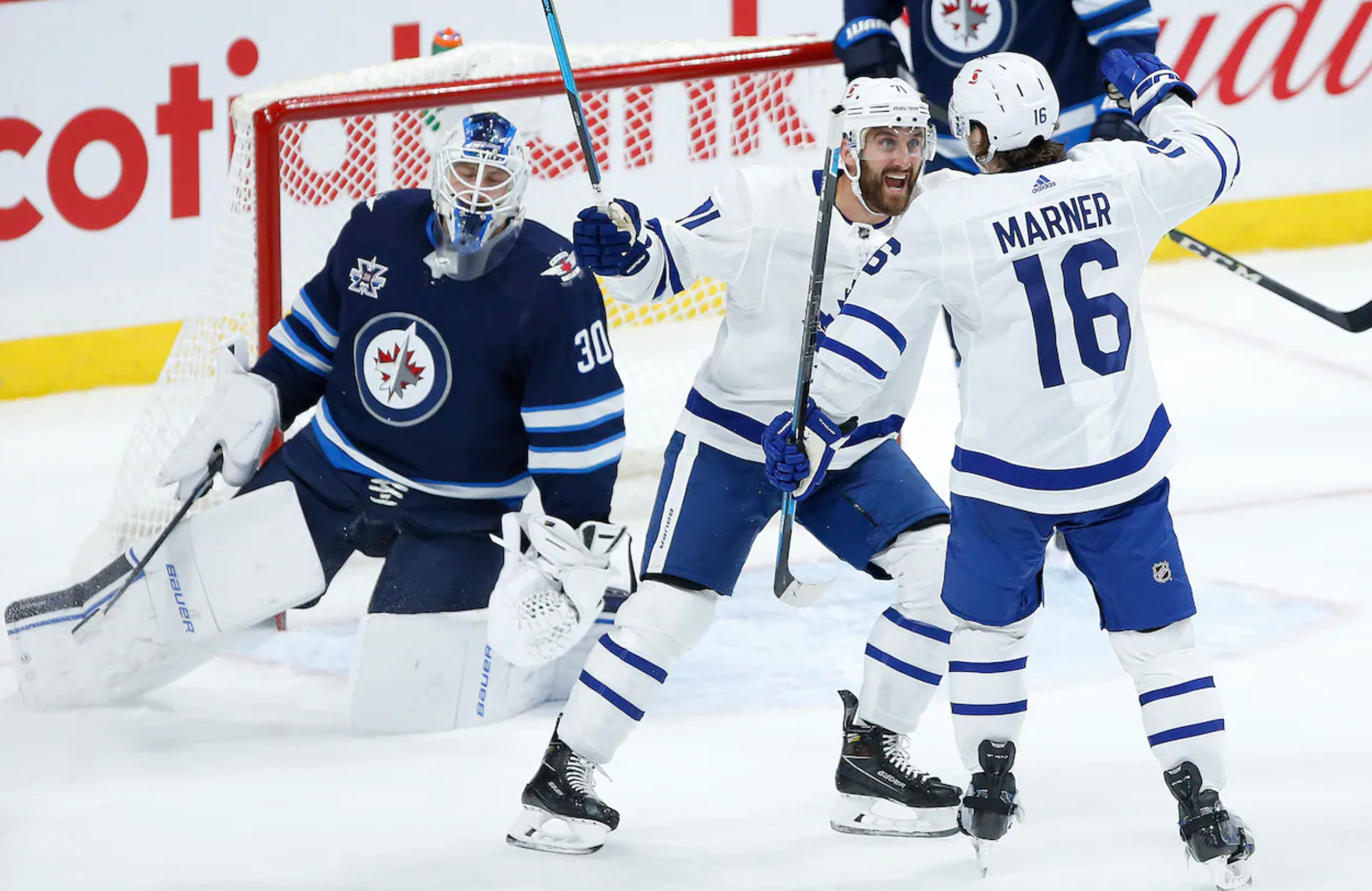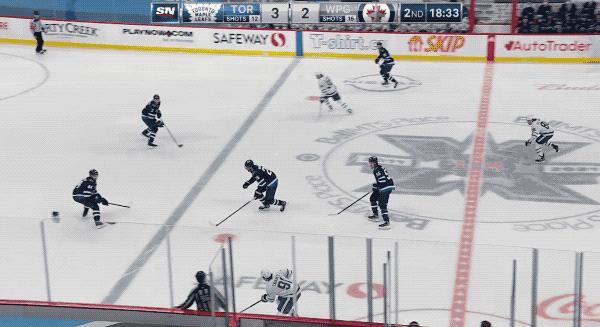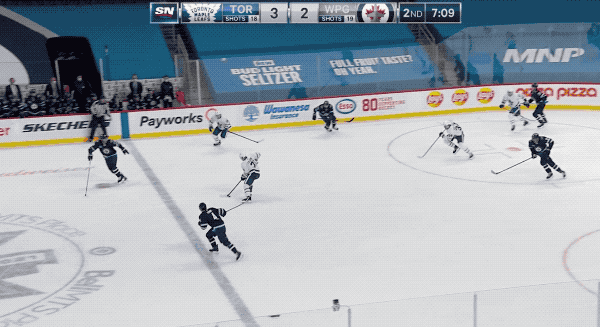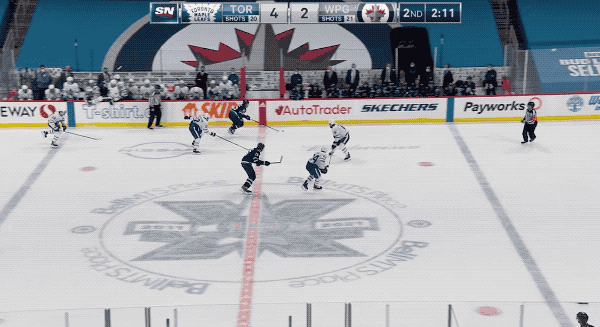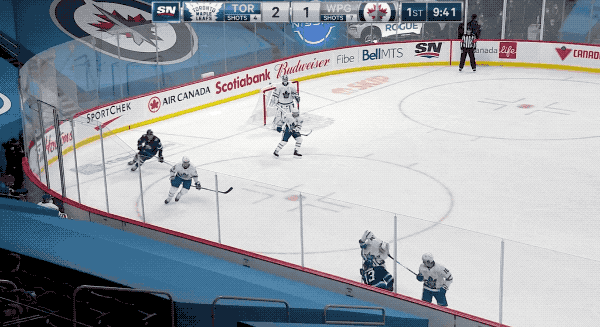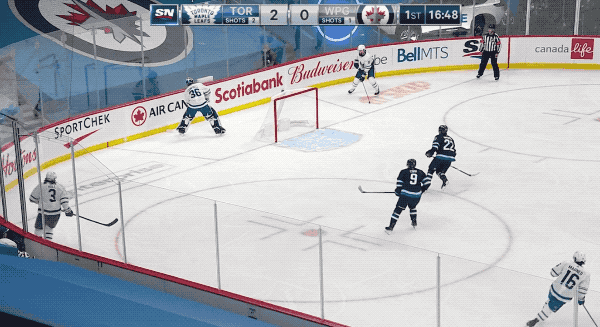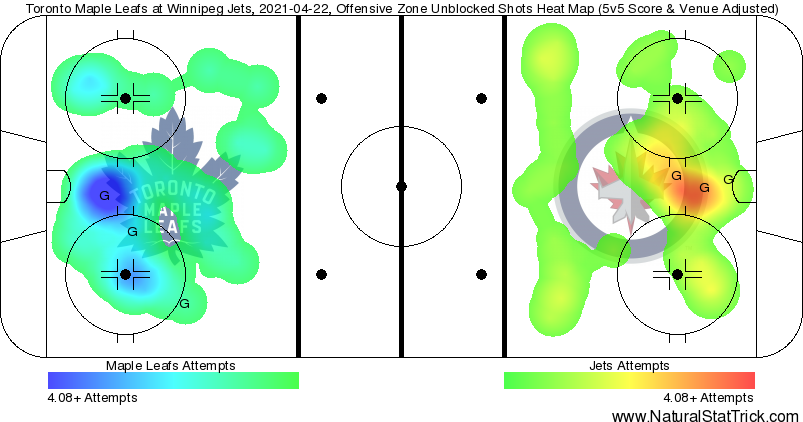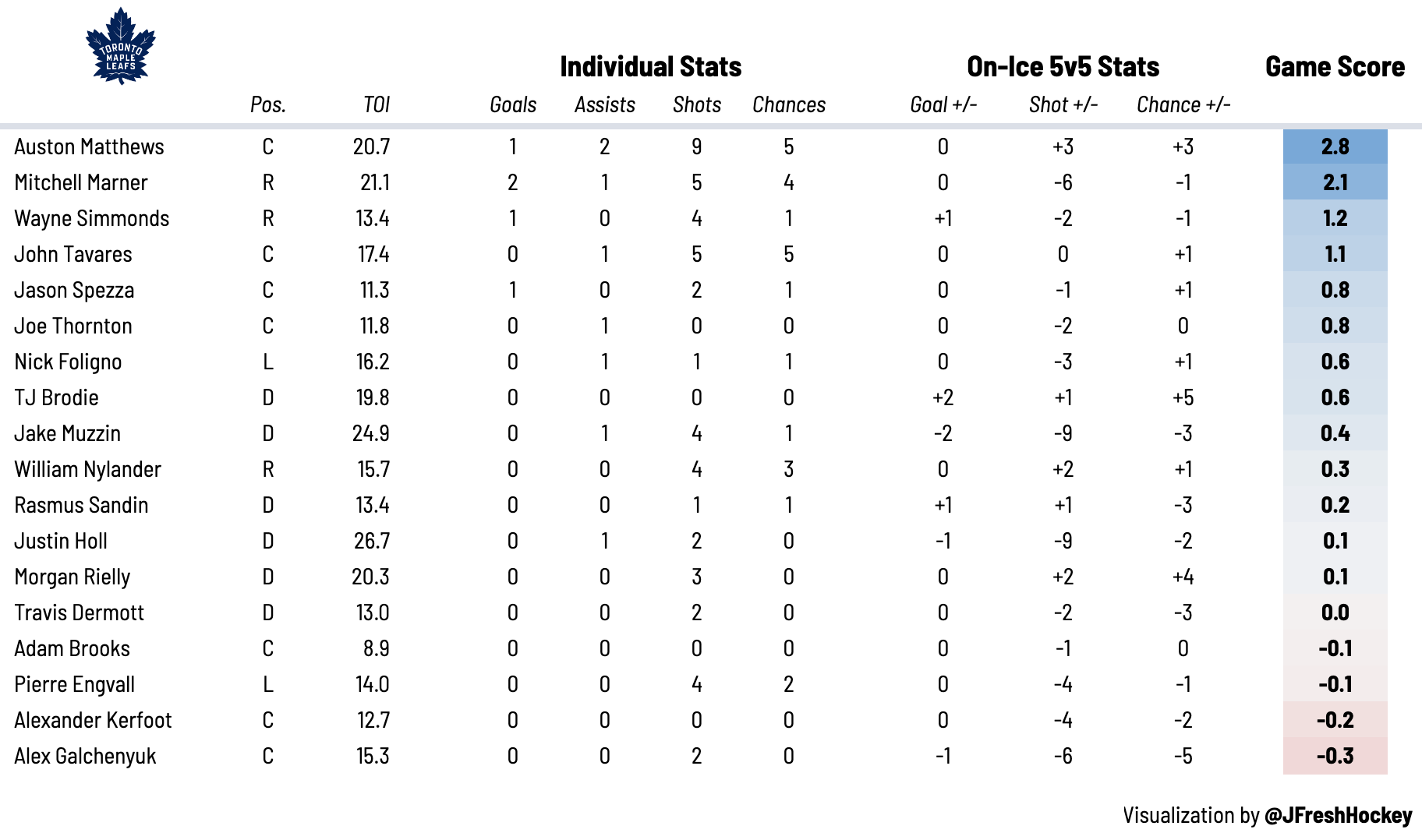After getting goalie’d in Vancouver, the Toronto Maple Leafs did some goalie-ing of their own tonight in Winnipeg.
It’s not every night you see Connor Hellebuyck get pulled after allowing goals on three of his first six shots. Toronto was able to hang on down the stretch after getting out to an early lead, eventually winning the game 5-3 thanks to an empty-net assist from the newly acquired Nick Foligno.
This was the veteran winger’s first game in a Leafs uniform, which we’ll break down when we get to his section. The game was a bit of a clunker for the most part; a lot of broken plays and missed passes resulted in some ugly hockey, but sometimes you need to win games like that.
To analyze things in a bit more detail, let’s go through each player individually. It’s some for some Leafs Report Cards!
5 Stars
Game Puck: John Tavares (C, #91) — He’s been looking confident with the puck on his stick lately. Earlier in the season, his play was troubling. We weren’t seeing those dynamic puck skills to break down opposing defenders in 1-on-1 situations.
Now? We’re seeing moves like these with regularity.
Tavares has been able to stick-handle his way into danger areas with consistency of late. It’s how he set up Wayne Simmonds for his backhand goal — by luring the defense out of the slot before setting up his teammate in a Grade-A shooting position.
Toronto’s captain was also throwing his weight around, absolutely crushing Josh Morrissey with a clean hit. Tavares also had a few great scoring opportunities, namely a power-play wrister from the left dot. The pucks didn’t want to go in for him tonight, but when you tie Auston Matthews for the team-lead with five slot chances, you know you’re doing something right.
Auston Matthews (C, #34) — Sometimes it’s just silly what Matthews-Marner are able to pull off when they find themselves in open space. That top line actually got hemmed in pretty badly for parts of the game — and they scored two goals because they can do things like this.
Or this.
This has been the Leafs‘ recipe for success all season: Put your two most talented players on the ice together and let them cook.
When you throw in the empty netter, Matthews finished the night with a goal and two assists, a team-leading nine shot attempts, and five chances from the slot. We’re running out of superlatives for him offensively at this point. If not for Connor McDavid’s 140-point pace, we’d probably be talking about Matthews as the Hart favourite right now.
One final note: Last game, I criticized Matthews for opting out of good shots. I think it’s safe to say he was playing with a shoot-first mentality tonight, as he should be considering he leads the league in goals with 34. The next closest player has 26.
Adam Brooks (C, #77) — I’ve been really impressed with Brooks’ play in these last few games. He’s playing with a lot of pace, using his speed to beat the opposing team’s slower bottom-six players.
There were a couple of times he was trying to do a bit too much with the puck — most memorably, over-passing it when Rasmus Sandin set him up in the slot — but for the most part, Brooks was one of Toronto’s more dangerous forwards at 5v5. His ability to make plays off the rush stood out in this game.
For example, he was able to make a quick deke after gaining the zone, which is how he drew a penalty. His line scored on the ensuing 6-on-5. Brooks also pulled off a few nice passes in transition, just missing Jason Spezza for a 2-on-1 one-timer, not to mention the backdoor pass he put on Pierre Engvall’s tape.
I never thought we’d be in a position where Sheldon Keefe had to find more minutes for Adam Brooks, yet here we are.
4 Stars
Mitch Marner (RW, #16) — That one-timer he let rip is a nice development in his game. Skill coaches will tell you if you want to become a better passer, you need to become a better shooter. Otherwise, the defender is going to back off of you and take away the passing lanes.
What’s interesting about Marner this year is that his shot rate hasn’t increased dramatically; it’s actually lower than it was from 2016-2019. His career-high 14.4 shooting percentage at 5v5 might have a lot to do with the perception that he’s shooting it harder this year, although it certainly looks that way to my eye. Then again, shooting percentage benders tend to throw off our eye test.
To quickly wrap up the rest of Marner’s night, he was excellent defensively alongside Foligno, both on the PK and in late-game situations while holding a lead. I’m sure that’ll be a combination we see more of when the Leafs are looking to shut things down.
Wayne Simmonds (RW, #24) — This was one of his better games of the season. My biggest criticism with Simmonds’ game has been plays dying on his stick, which wasn’t the case tonight. He was extending the play along the boards when the puck made its way to him, boxing out his man in tough areas so he could win the 50-50 battle.
He was also doing Wayne Simmonds things; going right at Matthieu Perreault when he landed on Jack Campbell, earning himself a “2 minutes, well worth it” penalty that the Mighty Ducks’ bash brothers would’ve been proud of.
Most importantly, he put the puck in the net.
Backhanders tend to be more random than your average shot type, but sometimes you need a bit of puck luck. Simmonds has been generating lots of shots from in tight lately, and he finally gets rewarded for it here.
The Old Guys — I love it when hockey teams try out a skilled fourth line. The combination of Thornton-Brooks-Spezza was one of the more dynamic bottom-six options we’ve seen offensively for Toronto this year. All three players can make the “next pass” off the rush, which resulted in a lot of tic-tac-toe plays up the ice.
Joe Thornton actually got some minutes towards the end of the game, with Keefe saying afterward that he trusts him in those situations. I can see why; Thornton did a great job of playing keep-away on the cycle, winning puck battles along the boards, and finding an open teammate on the perimeter. He also scored what appeared to be his first goal in forever, only to have it go off Jason Spezza‘s leg at the last moment.
Spezza was weirdly the third wheel on his line tonight, which I’m sure he didn’t mind considering some of the linemates he’s been forced to play with this season. My favourite moment of his actually came on the PK, when he got stuck out there after a faceoff loss. Unlike the other night, Spezza was moving his feet this time around, which allowed him to take away passing lanes and eventually get the puck back.
3 Stars
Nick Foligno (LW, #71) — I know Leafs fans were thrilled to watch Foligno’s first game in a Leafs uniform. Watching #71 closely in the first period, I didn’t have too many positive notes on him, and it sounds like he agrees.
Nick Foligno on his first game as a Leaf:
"Auston and Mitch were carrying me in the first, I felt pretty crappy. But slowly got my legs and felt a little better."
— Kristen Shilton (@kristen_shilton) April 23, 2021
As the game went on, he started to get more comfortable positionally. We saw him throw his weight around in puck battles, especially when he crunched Ehlers into the boards. Foligno’s main value comes defensively, which is where he made his biggest impact later in the game, helping to close out a one-goal lead and ice it with a selfless empty-net play.
It’s worth noting that a few plays were bobbling over his stick in the neutral zone, which matters when the opportunity cost is Matthews or Marner not getting the puck, but I don’t want to be Buzz Killington here. I’m happy that Leafs fans are happy with Foligno; I just think he can make a bigger impact with the puck, particularly on the cycle, as he settles into the team.
Travis Dermott (RD, #23) — While we’re on the buzzkill topic, I can’t wait for you to read my Sandin section and immediately stop taking my opinions seriously. The Sandin-Dermott pair was a lot of fun to watch, forcing Travis Dermott into a situation where he was the “stable” one on the pairing defensively.
That’s not a situation he’s found himself in…ever at the NHL level. I thought Dermott handled it well, winning puck battles along the boards, playing a tighter gap than Sandin in the neutral zone, and having a better stick in the defensive zone. It’s still infuriating to see Dermott fire point shots into shin pads, but if I’m evaluating his game as a whole, he was surprisingly good in a defensive role on Toronto’s third pair.
William Nylander (RW, #88) — I don’t have access to tracking data, but I’d imagine Nylander led the Leafs in OZ possession time with the puck on his stick. It was happening so often I found myself asking, “Is he holding onto it for too long?”
That sounds like a crazy question. Puck possession in the offensive zone is obviously a good thing, but there were a few times I thought Nylander had an opportunity to make a high-leverage pass through the middle of the ice and he turned it down. He still pulled off a few nice plays (i.e. an east-west pass to Jake Muzzin).
I’ve just come to expect so much from Nylander with the puck on his stick that tonight felt a tad underwhelming for me, especially considering how many times he had possession on the cycle.
Alex Kerfoot (C, #15) — I mentioned in my last report cards that Kerfoot has struggled on every line other than the Tavares-Nylander combination. That was technically true again tonight — Kerfoot’s line was outshot and out-chanced at 5v5 — but I’d argue Kerfoot actually held his own.
He’s become one of Toronto’s better puck retrievers on the forecheck, using his speed to beat the opposing defender to loose pucks in the corner. Now, part of the reason we notice his puck retrievals is because he’s dumping it in so often. From a defensive standpoint, it certainly has value to get the puck behind the other team’s defensemen, but it also limits what you can create offensively.
At this point, none of us expect Kerfoot to be a difference-maker offensively, so at least he’s making an impact on the defensive side of the puck.
Coaching Staff — I don’t have too many major criticisms for Toronto’s coaching staff tonight besides the minute-allocation on the power play. If you’re going to stack PP1, you need to stack their ice time as well. As fun as it was to watch Sandin quarterback PP2, it was less fun to watch Toronto’s five best players get only 40 seconds of power-play time.
The one thing I did love was Foligno’s usage when Toronto was holding a one-goal lead in the third period. Using him as the replacement for Spezza in the FOGO role seems like the right call in terms of getting Foligno on the ice alongside Marner in PK and 5v6 situations.
Jack Campbell (G, #36) — He’s mentioned that everyone keeps telling him to be kinder to himself, which I can relate to in life. A lot of us tend to be our own harshest critics, which can make it tough for an NHL goaltender to bounce back after letting a few save-able shots.
This felt like it was going to be a one or two-star night for Campbell early on, but he found a way to rally late and make some big stops to help Toronto secure the win, particularly on a few one-timers from Kyle Connor. I’d also like to point out how confident Campbell looked playing the puck, which obviously isn’t as important as stopping the puck, but it’s an added benefit when your goaltender can start the breakout if the other team is playing dump-and-chase hockey.
2 Stars
Rasmus Sandin (LD, #38) — Don’t worry, I watched the same game you did. I loved watching Sandin make plays with the puck in the offensive zone; walking the line on PP2; activating down the left wall at 5v5 before threading a pass to Brooks in the slot. These are all reasons I remain high on his upside.
The issue to me tonight was his play without the puck. Even the best players in the world have to defend 45 percent of the time. In those instances, Sandin was losing a lot of 50-50 battles. I also didn’t love his gap control tonight in transition defense, which has always been an area of strength in his game.
He’s a special player at threading passes up the ice, but there’s also a reason Toronto’s coaching staff has sheltered him so heavily at even strength and he saw just 13 minutes of ice time as the team protected its lead. He’ll need to show he can handle himself in the defensive zone if he’s going to earn more minutes at 5v5.
When it comes to 5v4 play, are we sure he isn’t better than Morgan Rielly at running a power play from the top?
Alex Galchenyuk (LW, #12) — I really want Galchenyuk to work in Toronto’s top six. If you can get away with playing him on a Matthews or Tavares line, it allows you to move either Zach Hyman or Foligno down to the third line, giving you three lines you trust at 5v5.
The issue is that Galchenyuk’s defensive warts have been more glaring recently.
I never love showing a player screw up on a goal against and concluding “see, he sucks defensively!” This is obviously just one isolated play, but Galchenyuk has been a defensive liability throughout his entire NHL career. It’s the reason this is his seventh stop in three years.
If he’s making enough skilled plays offensively to make up for his defensive woes, you can justify playing him higher in the lineup. Tonight, those plays included some nifty dekes into the slot, running PP2 well from the right half-wall, and a few creative passes that couldn’t quite connect.
In my opinion, that wasn’t enough tonight to justify what he was giving up defensively. We’ve seen that he can play better than this, and he (encouragingly) continues not to shortchange the team on effort and battle level, but it’s certainly a risky proposition moving forward. We know how much NHL head coaches hate risk if there isn’t production to justify it.
Justin Holl (RD, #3) — None of Toronto’s top-four defensemen had a fantastic night. It wasn’t a great look for Holl to be standing right next to Mark Scheifele when he scored from in tight, but Holl did get his stick on the puck — he just didn’t get a great bounce.
We can’t blame bounces for Holl getting beat over the top on a Pierre-Luc Dubois breakaway with 13 minutes left in a one-goal game. That’s just poor game management.
Speaking of poor game management.
The Rielly-Brodie Pair — I like to think of myself as someone who tries to make objective evaluations on players, which is why nights like these frustrate me so much. When Morgan Rielly and TJ Brodie were on the ice, the Leafs had positive metrics at 5v5. Shots, chances, goals, they were all at least 50%. Yet here I am, telling you I didn’t think they played well.
How the heck did you arrive at that conclusion, Ian?
Well, for one, this happened.
The “Big Mistake” is one every NHL defenseman has to deal with once in a while. Defensive zone turnovers result in goals against quite often, which is why you want to avoid bloopers like these. Alas, it was just one mistake. The bigger issue to me was Brodie missing on most of his bank passes up the ice.
With Rielly, my frustrations tonight are similar ones I’ve had in years past. As much as he creates offensively, he has a long track record of giving it all back via rush opportunities. His worst moment came later in the game, when Toronto was holding a one-goal lead, and he pinched up the ice to create offense, which led to an odd-man rush the other way for Winnipeg.
Rielly tends to be the “rover” in the offensive zone, which is what I tend to do in my NHL 21 squad, but when you’re holding a lead in the third period, I don’t think this is the greatest strategy.
Down by a goal? Roam around like there’s no tomorrow! Up by a goal? Maybe just worry about not giving up high-percentage chances. I’m sure my EASHL teammates would agree that Rielly and I need to “chill” in these instances, understanding the importance of game management in the third period.
Pierre Engvall (LW, #47) — We should probably note that Ilya Mikheyev was penciled in for Pierre Engvall’s lineup spot in practice. When the Soupman is healthy enough to play, I’d imagine he takes Engvall’s minutes.
As much as I want to root for the lanky, 6’5 Swede, he just won’t let me. Engvall insists on taking low-percentage shots from distance, killing the momentum he’s helped generate by carrying the puck up the ice.
I still think there’s a talented hockey player in there somewhere, but with Toronto heading into the final stretch here late in the season, Engvall appears to be on the outside looking in with respect to the pecking order up front.
1 Star
Jake Muzzin (LD, #8) — Can we talk about Muzzin’s puck-moving ability this season?
Again, this is just one play. I prefer relying on a larger sample size before arriving at any major conclusions, which is why I like diving into Corey Sznajder’s manual tracking data. Muzzin ranks dead last in controlled breakouts this year among Leafs defensemen — lower than Zach Bogosian. This is an area where Muzzin thrived last season.
He’s obviously still an excellent defensive player, but his limited puck-moving ability this season is cause for some concern, in my opinion — and I say this as someone who’s always loved Muzzin’s impact at 5v5.
Heat Map
Here’s a quick look at where each team’s shots were coming from at even strength, courtesy of Natural Stat Trick.
The Leafs had 51 percent of the shots and 54 percent of the scoring chances at 5v5 tonight, once again controlling the run of play.
The biggest difference tonight? Their goalie made more saves than the other team’s, which is what hockey often comes down to.
Game Score
Game score is a metric developed by The Athletic’s Dom Luszczyszyn to measure single-game performance. You can read more about it here.
Tweets of the Night
— JFresh (@JFreshHockey) April 22, 2021
For everyone who was burying him last season, myself included, how are we feeling about the Cody Cecy redemption tour?
My favourite part about Toronto's fourth line is that one player had 130 points in a single CHL season, and it wasn't Joe Thornton or Jason Spezza.
— Kevin Papetti (@KPapetti) April 23, 2021
After scoring 120 points in his D+2 season, Adam Brooks’ “reward” was another season in the WHL, where he put up 130 points for fun.
As nutty as those numbers are, what’s the point of keeping a player in junior that long? I can’t imagine he learned too much in that last year destroying teenagers.
5v5 Third-period statistics with Toronto in the lead:
Scoring chances: 7-3 Leafs
xGF% 62.2% for TorontoCampbell made some big saves at 5v6, but that's a really tidy defensive third period for the Leafs.
— Nick DeSouza (@NickDeSouza_) April 23, 2021
This was the big takeaway for me tonight. Toronto has done a much better job this season at preventing chances in the third period while holding a 1-goal lead. Adding a defensive presence like Foligno is only going to help in that department.
Is there a shortage of officiating in the NHL. Why do the Leafs get the same Chooch every game?
— Marietta Dubas (@grammadubie) April 23, 2021
Grandma Dubas speaking the truth. Also, I couldn’t be the only one who misread that tweet initially, right?























